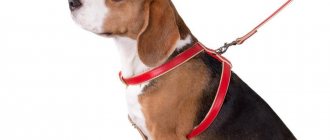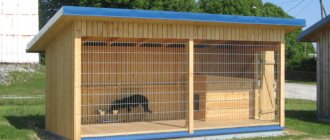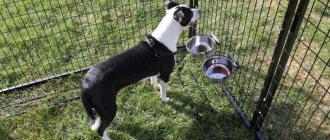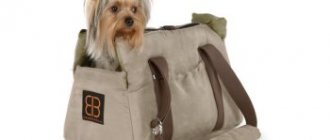When it comes to dog muzzles, many owners are outraged. They believe that their dog is smart, well-mannered and not at all aggressive. That’s why she doesn’t need this dog accessory. They don't take into account one detail. Often, a muzzle not only protects people from dogs (although this is its main purpose), but also helps to wean the dog from picking up anything from the ground. In this article we will tell you what types of muzzles there are, what they are made of and how to make a muzzle for a dog with your own hands.
Types of muzzles
What material is used to make this much-needed dog accessory? A dog muzzle can be made of metal or plastic, leather and even synthetic materials.
They can be deaf or mesh. Dog owners need to know that a deaf muzzle guarantees complete safety of people around them from animal bites. But it is not advisable to use it on a hot summer day, as it can cause heat stroke in the dog. After all, everyone knows that the cooling of an animal’s body occurs due to its frequent breathing with an open mouth.
Causes
There are several reasons why your pet begins to resist wearing a muzzle.
Inconvenience
The dog may simply be uncomfortable. Moreover, inconvenience should be understood not as the lack of habit of walking in a muzzle, but as the incorrect selection of a model. It is quite possible that the muzzle is simply too large, which is why it can be easily removed. Another option is that he presses or does not allow the dog to breathe calmly, which greatly irritates him.
In previous materials we have already told you how to choose the right muzzle and how it should fit, but let us once again recall the most important aspect that should be taken into account when choosing: the animal must be able to breathe freely and even open its mouth slightly to stick out its tongue when it will be hot. Even the most stringent protection models provide dogs with this opportunity.
Unpleasant Memories
When accustoming a puppy to a collar, leash, harness and, of course, a muzzle (and this procedure should, of course, take place as early as possible), all experienced dog breeders note the importance of creating the right mood in the pet. If the owner raised his voice or, even worse, beat a disobedient puppy trying to get out of an unknown and extremely uncomfortable device or chew it, the animal can quickly form a simple connection “muzzle = owner’s anger and punishment.”
No matter how much the puppy resists, you should not allow unpleasant memories to be associated with a muzzle or any other accessory necessary for a walk. In the future, they can seriously complicate education and training.
Relationship problems
Any owner, even if he has never been interested in the intricacies of training and the psychology of dog behavior, sooner or later notices that his pet treats people differently - he listens to one, and not to another. The thing is that the dog subconsciously builds a hierarchy, dividing family members into those who are above it (accordingly, he needs to obey) and below (the instructions of these people may well go unheeded).
There are often cases when the owner does not try to educate his pet, so the dog decides that he is on the same level or even higher than the person. In this case, attempts to put a muzzle on can cause a response, even anger and growling.
We sew a muzzle ourselves
Today there is no shortage of choices of different muzzles for dogs of all breeds, especially in large cities. However, many pet owners prefer to sew it for their pet themselves. Well, let's try to do this together. Perhaps our advice will be useful to you. In addition, making muzzles for dogs with your own hands is not at all difficult.
The muzzle must be made of high-quality and durable materials. This applies to all dog breeds, but especially large animals.
It is better to choose a fabric of a neutral color that allows air to pass through well. Thick cotton material is ideal in this case.
Making a homemade muzzle
If your pet is not large in size and is a representative of one of the decorative breeds, you will still need a protective device such as a muzzle.
In most cases, such babies are left with nothing, since it is very difficult to find a protective accessory for their miniature faces in pet stores. Thus, conscious owners have adapted to making them themselves.
Here the manufacturing process is very simple:
- Look in one store for the model of the item that you like best;
- make the correct pattern based on the size indicators of your pet;
- it is worth purchasing durable and high-quality fabric;
- make separate strips, sew them together and attach a strip with a fastener to them.
The item is ready, you can try it on.
Let's start sewing
Fold each of the strips in half, fold it in half again and carefully stitch it on the machine. Also process all the remaining strips that will make up the future muzzle for the dog. Then, using perpendicular seams, connect the strips together. Take pre-prepared straps that will secure the muzzle, sew a fastener to one end, and make holes on the other. Sew the straps to the sides of the muzzle. Now you will learn how to sew muzzles for dogs. A handmade accessory for your pet will undoubtedly please the owner. I would like your pet to be happy with this purchase.
Muzzles for small dogs
We foresee the bewilderment of owners of decorative or simply small breeds of dogs. They often refuse to understand why their pets' adorable little faces need to be muzzled. They are especially upset when, entering a pet store, they see powerful metal samples intended for large animals. In this case, the owners of small dogs can only rely on their own strength and make a dog muzzle with their own hands.
For this job you will need:
- thick, preferably cotton fabric;
- soft tailor's measuring tape;
- thread No. 10 to match the fabric;
- two straps;
- clasp.
First measure the length of the protruding part of the muzzle from the eyes to the tip of the nose. Take the necessary measurements using a soft tailor's tape, first at the top of the muzzle, then at the sides, and finally at the bottom. Measure the distance from the back of your head to the tip of your nose.
As in the first case, we will sew a muzzle for small breed dogs from separate strips. And not because it’s easier to do it this way, but because the dog will be comfortable in such an accessory, especially on hot days.
Cut out the required number of strips, process them in the same way as in the first case, and assemble. This type of muzzle is ready. The process of making such a muzzle can be simplified if you replace strips of fabric purchased in a store with thick braid and fasten it with metal rivets.
For winter time, you can make the muzzle solid, i.e. not from separate strips, but from one piece of fabric or leather.
To do this, you need to build a pattern in the shape of a trapezoid. Its upper side will be equal to the circle under the muzzle and above the eyes, divided into two. The lower side of the trapezoid is equal to the circumference of the mouth, also divided into two. The distance between the top and bottom sides of the trapezoid is equal to the length of the muzzle from the eyes to the tip of the nose.
Cut out a pattern from paper and attach it to the fabric with pins. Cut the workpiece taking into account seam allowances. Finish the pieces (except the sides) with a hem stitch and sew the sides together. Sew a thick ribbon with a fastener or a strap to them. That's it, the dog muzzle for the cold season is ready.
Making an improvised muzzle for a dog
This product can be very effectively made from any available items. In most cases, the following are used for this purpose: a bandage, a short cord, a ribbon, a belt, a tie or tights.
A loop is made from a handy object, thrown over the dog’s face and tightened on the back of the nose. In order for the protection to be more durable, it is worth making another loop and re-fastening it. After this, the ends are brought together at the ears and tied into one bow.
It is also worth considering that the product must be tightened tightly enough so that the dog cannot pull it off with his paw and open his mouth.
If the baby starts to “rage”, you just need to throw a thick cloth or a small towel over his head. Some dogs can be left with eyes so that the pet can observe what is happening. However, as practice shows, small breeds come to their senses and calm down faster when their entire muzzle is covered.
Based on all that has been said, we can conclude that it is not necessary to purchase an expensive muzzle in a store, since it can be quite effectively produced independently. For this you will need a variety of available materials, a little skill and master classes from the Internet.
How to train a dog to wear a muzzle?
It's no secret that most dogs are not too fond of this accessory. Experienced dog handlers accustom the animal to it from an early age. But what if your adult dog needs to be trained to wear a muzzle in public?
In this case, you cannot use force, much less punishment. Place a piece of your pet’s favorite treat in the “new thing” and let him get it himself. If successful, praise him. Repeat this activity 4-5 times every day for a week. After this, try fastening the muzzle. Do not rush to remove it until your four-legged friend has completely calmed down. Wear it for a short time at first, but gradually increase the duration until the dog gets used to it.
How to make a muzzle yourself
In accordance with the law on the contents of domestic animals, any dog in a public place must be muzzled . Owners of dogs of decorative or lightly small breeds often do not understand the situation at all when they have to purchase a muzzle for the small faces of their pets. It becomes extremely sad in a pet store; the owner discovers there a whole series of strong muzzles designed to restrain the dog from biting and not a single one of them is suitable for a small face. In this case, owners of dogs of small breeds and dogs with non-standard muzzles can only sew the muzzle themselves.
You will need
- – thick fabric, preferably cotton;
- – measuring tailor’s tape;
- – thread No. 10 to match the fabric;
- – two straps;
- – strap clasp.
Instructions
1. A muzzle for non-aggressive dogs, worn especially to comply with the letter of the law, is best sewn from high-quality woven material. Choose a fabric in neutral colors that is highly breathable. Various types of thick cotton fabrics are best suited for each. 2. Take measurements of your dog's face. When measuring, leave a small allowance for the slightly open mouth. First, measure the length of the protruding part of the muzzle from the tier of the eyes to the tip of the nose. Take measurements with a soft tailor's tape at the top of the muzzle, along the sides, and then from the bottom. Lastly, measure the distance along the side line of the muzzle from the tip of the nose to the occipital point on the dog’s head. Record all measurements taken.
3. Draw a pattern for the future muzzle. It will be cooler than each if it consists of individual strips 0.5–1 cm wide, depending on the thickness of your dog’s muzzle.
4. In accordance with the measurements and the pattern, cut out the required number of fabric strips from the material, 4 times wider than the width of the muzzle strips you need. First fold each strip in half so that both ends point inward. After this, fold it in half again, leaving the raw edges of the fabric inside the strip. Sew the folded strip at a distance of 1-2 mm from the opening edge. One piece for the muzzle is ready.
5. Carry out all the details of your dog’s muzzle in the same way. After that, sew them together according to your pattern. The seams of the perpendicular connection of the strips are carried out along the boundaries of each intersection and, additionally, diagonally. 6. Take the straps that you plan to use to secure the muzzle on the dog’s head. Sew a fastener to one of the 2 straps on one side. On the second strap, also make holes in the center on one side, in which the clasp will be fixed when fastened. Seal the holes tightly with thread to prevent the strap fabric from unraveling. In accordance with the measurements, leave the straps the required length so that you can freely fasten the muzzle on the dog’s head. Cut off the rest of the straps. Sew the straps with the free ends to the sides of the muzzle. 7. That's it, the muzzle is ready. Try it on your dog and fasten it at the back with a clasp. You can safely go out with your pet to a social place.
Buying a muzzle for a dog is a primitive thing, but only at first glance. When choosing this accessory, you should consider not only the size of your pet's muzzle and jaw, but also the function and even the shape of the muzzle.
Instructions
1. Mesh muzzles are suitable for peaceful, non-aggressive dogs. This accessory is made of leather or plastic. Similar restraints for animal jaws can be used for participation in competitions and exhibitions and can be easily used for walking the dog in the yard. But a leather muzzle can chafe if it is not chosen correctly and is too small in size, so when purchasing this type, be sure to take your dog to try it on. Plastic mesh muzzles look great. But they have the ability to crack from impact and in the cold, while, say, solid leather ones will be much stronger and more reliable. 2. A mesh metal muzzle is the perfect option for hot summers. However, it is not suitable for winter, because in cold weather the dog can “stick” its lip or tongue to the metal. Even leather inserts do not completely exclude this possibility. 3. Muzzles with insulation - a winter option for walks. Finally, it looks bulkier and is much heavier in weight, however, it is much more protective of your dog’s face in severe frost, due to the foam rubber that is sewn in as insulation. But an insulated muzzle is unsuitable for walks in summer and even spring, as it can cause diaper rash. 4. The double metal muzzle prevents the dog from eating “illegal” food from the street, and is also great for very angry and hostile pets. When choosing a double mesh restrictor, pay attention to the mesh: the front grille should consist only of vertical bars, since your pet can break its teeth on the horizontal bars if it tries to bite something. 5. Owners choose solid leather muzzles for angry guard dogs or police dogs. Unlike mesh iron or leather baskets, a “deaf” muzzle perfectly holds its shape and calms the dog’s aggression. Such models are excellent during detention training and for developing excellent grip. They, as usual, are made of thick, sometimes double-layer leather with excellent fastening. Video on the topic Useful advice For a dog, a cylindrical muzzle is very comfortable, in which it is easy to open the mouth and stick out the tongue. If the head fits too tightly, this abnormally selected accessory may cause the animal to suffer from heatstroke. Make sure that the muzzle does not cut into the head under the eyes, under the chin, or put pressure on the dog’s nose. Many of the attachments for this muzzle stopper have a comfort strap that fastens behind the ears. This model is suitable if the dog is not bothered to take off the muzzle.
A muzzle will serve as a humane and effective means of controlling a dog’s reactions while teaching it peaceful behavior. A wide range of shapes and sizes will allow you to choose a muzzle for a dog of any breed.
You will need
- – clicker;
- – muzzle;
- – delicacy
Instructions
1. In most cases, it is recommended that your dog wear a mesh muzzle. It is considered more harmless, unlike nylon, because it allows the animal to breathe freely by sticking out its tongue. Before you start training your dog to wear a muzzle, determine which treats he particularly enjoys. It would be a good idea to consult a veterinarian on this issue. Soft, non-crumbling slices are especially suitable. A dog that does not have to lick crumbs from the floor or chew hard pieces will learn much faster. Serve the treat not from your fingers, but on your palm, so that the animal does not damage your hand. 2. Buy a clicker at the pet store - a plastic keychain with a metal tongue, one that makes a clicking sound when pressed. The unique sound of the clicker will serve as a signal to the dog that it has performed the required action. First, train your dog to hear the click every time he gets a treat. When the animal realizes that the signal is invariably accompanied by a treat, it can be used to mark those moments when some cool action is performed. 3. Tie your pet on a leash, and its other end to the leg of a chair or your leg. Take the clicker and squeeze the treat in your palm. Wait until the dog stops trying to get the treat from your hand and, having clicked once, open your palm. After that, take another slice and continue going about your business, say, reading a book, ignoring your four-legged friend. 4. After about five minutes, click again and offer a treat. Repeat the click sequence with the treat every five minutes so that the dog knows exactly when the new signal will be heard. As a result, the dog will begin to turn towards you when you click, waiting for a treat. The clicker click can be replaced with a word pronounced with a special intonation. 5. When introducing the dog to the muzzle, hold it in one hand, and the treat and clicker in the other. In this case, the pet should sit or stand opposite you. Hold out the muzzle and let your dog sniff it. When she does this, make a clicking noise and offer a treat. 6. After this, move the muzzle towards you. If the animal does not want to smell it, rub it with a slice of treat. After 30-60 seconds, bring the muzzle to the dog's nose again and after he sniffs it, click the clicker and give the treat. Repeat these steps until the dog begins to confidently bring his nose to the muzzle. 7. Train your pet to put his nose in the muzzle. Hand it to the dog, wait until he comes up to it and touches it with his nose. After the click, treat her with a treat. Repeat about ten times until the dog touches the muzzle with his nose readily. The next time you touch the muzzle with your nose, she should not hear a click, but you continue to hold the muzzle. When the dog nudges him with his nose, make a click with further reward. Repeat this five times. 8. Now, when the dog touches the muzzle, turn it so that the animal’s nose is partly inside. When this happens, give a signal and reward. As soon as the dog learns to place his entire nose in the muzzle, teach him to keep his muzzle there. Make a click with the clicker, keeping the time longer and longer with each approach, bringing it up to ten seconds. 9. In the following training sessions, make a clicking sound when holding the strap behind the dog's ears, then when fastening it. After fastening the straps, immediately make a click, unhook the straps and allow the dog to remove his muzzle to get a treat. When training your dog to wear a muzzle for a long time, teach him to take treats from the side holes in the muzzle. Play more with your pet and take him for walks, this will help him take his mind off the muzzle and quickly get used to it. Video on the topic Please note! Do not under any circumstances make the muzzle “deaf.” The ease of doing it is not worth the subsequent pain your dog will suffer while wearing it. Free breathing is the main component of a successfully sewn muzzle. Helpful advice Avoid using fabrics with shiny colors, no matter how much you like them. Your dog will have to wear a muzzle, but he has completely different tastes - a shiny color should not flash before his eyes. Traditionally, fabric of dark colors is chosen - black, chestnut or gray; Do not use rivets to fasten parts of the muzzle. They noticeably make the structure heavier and rust when wet. This can have a negative impact on your dog's skin.











